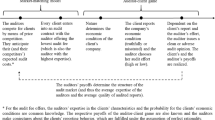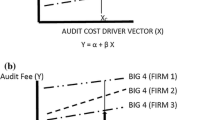Abstract
We use a structural application of the discrete choice model to investigate how the introduction of a joint audit policy would affect audit market structure and consumer surplus. We perform this policy evaluation by identifying demand fundamentals in a joint audit regime and applying them to a single audit regime. We find that a joint audit requirement has the potential to change the audit market structure substantially but that the effects are sensitive to the specific policy design. For example, small audit firms gain market share in a joint audit regime but only if an equal sharing of the workload between the two joint auditors is not required. Our counterfactual analysis reveals that the introduction of a joint audit regime would be associated with a substantial loss of consumer surplus. The loss results from restricting clients from giving all of the audit work to their most preferred audit firm, but it is partly offset by gains in consumer surplus deriving from the opportunity to choose the best combination of auditor pairs.





Similar content being viewed by others
Notes
The demand model imposes only a slight amount of horizontal differentiation via the error term included in the logit model.
As a robustness check, we also estimate the model with the non-log predicted audit fees applying the correction procedure as in Wooldridge (2003, 207). The estimation results remain similar.
The total number of possible combination of pairs of seven individual auditors is \(\left ({~}_{2}^{7}\right )=21\). In addition, it is possible to pick two small audit firms, resulting in 22 combinations overall.
A classical example where alternatives are very similar to each other is the “red bus, blue bus” problem (Train 2009, 50)
Please find the detailed derivation of the equation in the Appendix.
We thank the referee for suggesting this robustness test.
As a further validity check, we estimate a specification of the audit fee model that includes future realized values of MA_IND instead of prior year values. In untabulated regression analyzes, we find that the negative effect of MA_IND becomes gradually weaker for future realized values of MA_IND and insignificantly for values four years in the future. These findings suggest that merger activity leads price changes and not the reverse, providing support for the supply-shift effect of M &A.
The demand estimation includes 24,662 observations because each of the 1,121 client firms is included for each of the 22 possible auditor-pair combinations.
We also implement bootstrapping to correct the standard error for the two-step estimators (Petrin and Train 2010) and observe that it does not change the results of our estimation.
We use the predicted auditor choices in the UK single audit regime as a benchmark for the predicted auditor choices in counterfactual UK joint audit regimes to control for potential prediction error.
References
Ackerberg, D., Benkard, C.L., Berry, S., & Pakes, A. (2007). Econometric tools for analyzing market outcomes. Handbook of Econometrics, 6, 4171–4276.
André, P., Broye, G., Pong, C., & Schatt, A. (2016). Are joint audits associated with higher audit fees? European Accounting Review, 25(2), 245–274.
Ball, R., Jayaraman, S., & Shivakumar, L. (2012). Audited financial reporting and voluntary disclosure as complements: a test of the confirmation hypothesis. Journal of Accounting and Economics, 53(1), 136–166.
Barker, A., & Jones, A. (2011). ‘Big Four’ accountants face audit reform. Financial Times. Available at https://next.ft.com/content/a4f58dba-1a89-11e1-ae4e-00144feabdc0.
Bédard, J., Piot, C., & Schatt, A. (2014). An evaluation of the French experience with joint auditing. Working paper. Available at SSRN: http://ssrn.com/abstract=2165595.
Berry, S., Levinsohn, J., & Pakes, A. (1995). Automobile prices in market equilibrium. Econometrica, 63(4), 841–890.
Berry, S., Linton, O.B., & Pakes, A. (2004). Limit theorems for estimating the parameters of differentiated product demand systems. The Review of Economic Studies, 71(3), 613–654.
Brown, S.V., & Knechel, W.R. (2016). Auditor–client compatibility and audit firm selection. Journal of Accounting Research, 54(3), 725–775.
Christiansen, M., & Loft, A. (1992). Big players and small players: a study of increasing concentration in the Danish market for auditing services. European Accounting Review, 1(2), 277–301.
Deng, M., Lu, T., Simunic, D.A., & Ye, M. (2014). Do joint audits improve or impair audit quality? Journal of Accounting Research, 52(5), 1029–1060.
Dube, J.-P., Chintagunta, P., Petrin, A., Bronnenberg, B., Goettler, R., Seetharaman, P., Sudhir, K., Thomadsen, R., & Zhao, Y. (2002). Structural applications of the discrete choice model. Marketing Letters, 13(3), 207–220.
European Commission (2010). Green Paper audit policy: lessons from the crisis. Available at http://ec.europa.eu/finance/consultations/2010/green-paper-audit/index_en.htm.
European Commission (2011). Proposal for a regulation on specific requirements regarding statutory audit of public-interest entities. Available at http://ec.europa.eu/finance/auditing/reform/index_en.htm.
European Commission (2014). Regulation on specific requirements regarding statutory audit of public-interest entities and repealing Commission Decision 2005/909/EC. Available at http://eur-lex.europa.eu/legal-content/EN/TXT/?uri=CELEX:32014R0537.
Evans, L., & Schwartz, J. (2014). The effect of concentration and regulation on audit fees: an application of panel data techniques. Journal of Empirical Finance, 27, 130–144.
Fan, J.P., & Wong, T.J. (2005). Do external auditors perform a corporate governance role in emerging markets? Evidence from East Asia. Journal of Accounting Research, 43(1), 35–72.
Francis, J.R. (2004). What do we know about audit quality? The British Accounting Review, 36(4), 345–368.
Francis, J.R., Reichelt, K., & Wang, D. (2005). The pricing of national and city-specific reputations for industry expertise in the US audit market. The Accounting Review, 80(1), 113–136.
Francis, J.R., Richard, C., & Vanstraelen, A. (2009). Assessing France’s joint audit requirement: are two heads better than one? Auditing: A Journal of Practice & Theory, 28(2), 35–63.
Francis, J.R., Michas, P.N., & Seavey, S.E. (2013). Does audit market concentration harm the quality of audited earnings? Evidence from audit markets in 42 countries. Contemporary Accounting Research, 30(1), 325–355.
Francis, J.R., Mehta, M.N., & Zhao, W. (2016). Audit office reputation shocks from gains and losses of major industry clients. Working paper. Available at SSRN: http://ssrn.com/abstract=2787269.
Gerakos, J., & Syverson, C. (2015). Competition in the audit market: policy implications. Journal of Accounting Research, 53(4), 725–775.
Gonthier-Besacier, N., & Schatt, A. (2007). Determinants of audit fees for French quoted firms. Managerial Auditing Journal, 22(2), 139–160.
Government Accountability Office (2008). Audits of public companies: continued concentration in audit market for large public companies does not call for immediate action. Available at http://www.gao.gov/products/GAO-08-163.
Griffin, P.A., & Lont, D.H. (2007). An analysis of audit fees following the passage of Sarbanes-Oxley. Asia-Pacific Journal of Accounting & Economics, 14(2), 161–192.
Hay, D.C., Knechel, W.R., & Wong, N. (2006). Audit fees: a meta-analysis of the effect of supply and demand attributes. Contemporary Accounting Research, 23 (1), 141–191.
Hope, O.-K., Langli, J.C., & Thomas, W.B. (2012). Agency conflicts and auditing in private firms. Accounting, Organizations and Society, 37(7), 500–517.
Jones, H. (2012a). EC says auditors “over lobbying” against EU reform. Reuters. Available at http://uk.reuters.com/article/uk-eu-auditing-idUKBRE82Q0XN20120327.
Jones, H. (2012b). Firms in EU face joint checks in auditing shake-up. Reuters. Available at http://www.reuters.com/article/eu-accounting-idUSL5E8KI88120120918.
Jones, H. (2013). EU states in breakthrough over accounting reform. Reuters. Available at http://uk.reuters.com/article/uk-eu-accounting-idUKBRE9930SU20131004.
Keane, M.P., Todd, P.E., & Wolpin, K.I. (2011). The structural estimation of behavioral models: discrete choice dynamic programming methods and applications. Handbook of Labor Economics, 4, 331–461.
Kermiche, L., & Piot, C. (2016). The audit market dynamics in a mandatory joint audit setting–the French Experience. Journal of Accounting, Auditing & Finance. Forthcoming.
Knechel, W.R., Niemi, L., & Sundgren, S. (2008). Determinants of auditor choice: evidence from a small client market. International Journal of Auditing, 12(1), 65–88.
Kortekaas, V. (2013). Competition Commission dilutes audit reforms. Financial Times. Available at https://next.ft.com/content/794b6b92-358c-11e3-b539-00144feab7de.
Le Vourc’h, J., & Morand, P. (2011). Study on the effects of the implementation of the acquis on statutory audits of annual and consolidated accounts including the consequences on the audit market. ESCP Europe Report.
Lesage, C., Ratzinger-Sakel, N.V., & Kettunen, J. (2016). Consequences of the abandonment of mandatory joint audit: an empirical study of audit costs and audit quality effects. European Accounting Review. Forthcoming.
McFadden, D. (1973). Conditional logit analysis of qualitative choice behavior. In Frontiers in econometrics (pp. 105–142). New York: Academic Press.
McFadden, D. (1999). Computing willingness to pay in random utility models. Trade, Theory and Econometrics: Essays in Honour of John S. Chipman, 15, 253–274.
Petrin, A., & Train, K. (2010). A control function approach to endogeneity in consumer choice models. Journal of Marketing Research, 47(1), 3–13.
Ratzinger-Sakel, N., Audousset-Coulier, S., Kettunen, J., & Lesage, C. (2013). Joint audit: issues and challenges for researchers and policy-makers. Accounting in Europe, 10(2), 175–199.
Sikka, P. (2013). The race is on, but the field is limited in the auditing business. The Conversation. Available at http://theconversation.com/the-race-is-on-but-the-field-is-limited-in-the-auditing-business-16639.
Simunic, D.A. (1980). The pricing of audit services: theory and evidence. Journal of Accounting Research, 18(1), 161–190.
Srinidhi, B.N., He, S., & Firth, M. (2014). The effect of governance on specialist auditor choice and audit fees in US family firms. The Accounting Review, 89(6), 2297–2329.
Terza, J.V., Basu, A., & Rathouz, P.J. (2008). Two-stage residual inclusion estimation: addressing endogeneity in health econometric modeling. Journal of Health Economics, 27(3), 531–543.
Tóth, Á. (2014). Reputation effects in the market of certifiers: evidence from the audit industry. Economic Inquiry, 52(2), 505–517.
Train, K.E. (2009). Discrete choice methods with simulation. Cambridge: Cambridge University Press.
UK Competition and Markets Authority (2014). Statutory audit services market investigation. Available at https://www.gov.uk/cma-cases/statutory-audit-services-market-investigation.
UK Parliament Report (2011). Government response to report on auditors: market concentration and their role. Available at http://www.publications.parliament.uk/pa/ld201012/ldselect/ldeconaf/157/157.pdf.
Wooldridge, J. (2003). Introductory econometrics: a modern approach. South-Western, a part of Cengage Learning.
Acknowledgements
We thank Peter Easton (editor) and the anonymous reviewer for their constructive comments. We appreciate the helpful comments of John Christensen, Francesca Franco, Joachim Gassen, Ole-Kristian Hope, Kim Ittonen, Kathleen Nosal, Victor Reinhardt, Philipp Schmidt-Dengler, Dirk Simons, Naoki Wakamori, Jörg Werner and the seminar participants at the University of Mannheim, University of Mainz, University of Graz, University of Gothenburg, the EAA annual conference, the EIASM workshop on Accounting and Economics, the AAA Audit mid-year conference, the 8th EARNet Symposium and the Berlin Accounting Workshop. Aiyong Zhu gratefully acknowledge the support from the Chinese National Science Foundation (under grant 71502131). All authors contribute equally to this paper.
Author information
Authors and Affiliations
Corresponding authors
Appendix
Appendix
1.1 Conditional choice probability
The choice probability \(Pr_{(j,k)}^{it}\) of choosing a pair of audit firms is:
Set A nm = V int + V imt +Γ it (n,m) −(V ikt + V ijt +Γ it (j,k)), ∀n≠i,m≠k. Given the type 1 extreme value distribution of \(\varepsilon _{lkt}^{i}\) for all l and k, the difference of \(\varepsilon _{jkt}^{i}-\varepsilon _{nmt}^{i}\) follows the logistic distribution, which yields to a closed form solution for the above integration as,
Rights and permissions
About this article
Cite this article
Guo, Q., Koch, C. & Zhu, A. Joint audit, audit market structure, and consumer surplus. Rev Account Stud 22, 1595–1627 (2017). https://doi.org/10.1007/s11142-017-9429-8
Published:
Issue Date:
DOI: https://doi.org/10.1007/s11142-017-9429-8




